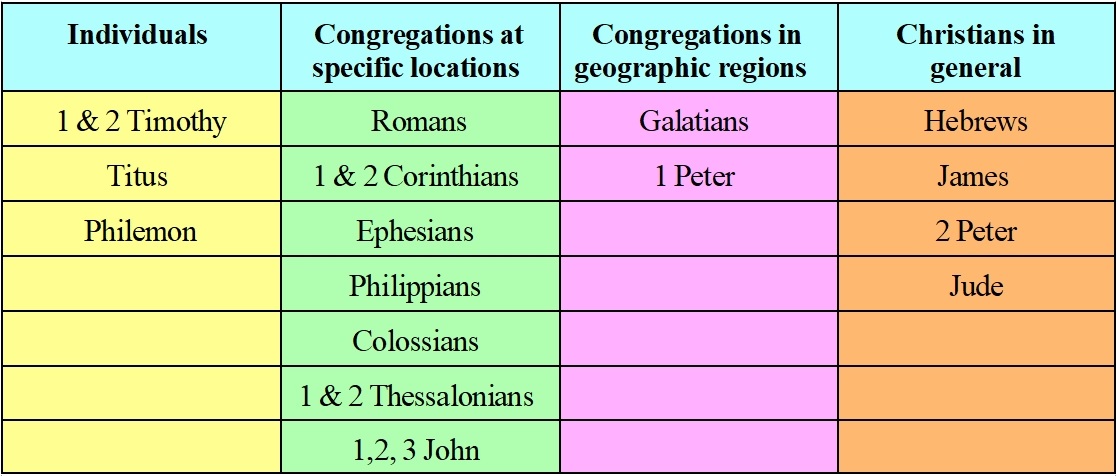TLCBiblical.com
Accuracy In Biblical Education
1. Introduction
The second main division of the Bible is more familiar to folks but the relationship between it and the Old Testament is often misunderstood. In this video we'll begin to identify and clarify these points as we examine an overview of the New Testament
2. Clarification of terms
As with the Old Testament we need to understand and create a distinction in terms used to describe this collection of books. The term New Testament can be used in two ways. The first of these is as a description of its 27 books written during the first century. The second way in which we can use this term is to refer to the doctrine of the New Testament. As we continue these studies we'll see that the New Testament is a law. We'll clarify this point as we continue our basic lessons and will discuss it in more depth in later videos dealing with doctrine. Let's talk about the uses of these to understand this point better.
3. A biblical timeline
In a later video I'll construct a timeline of God's spiritual laws but we do need to discuss some of this now in order to understand the relationship of the Old & New Testaments as well as the doctrinal differences. In a previous video it was noted that the period governed by the Law of Moses did not end with the events or time period covered by the last prophet Malachi. Christ lived and died under the period governed by the Law which causes confusion for some. The New Testament books, begin with the life of Christ but don't mark an immediate transition of the Law to the era of the New Testament. The New Testament, speaking of the doctrinal period officially begins in Acts chapter 2 on the day of Pentecost with the establishment of the church. We'll cover these events later in more detail as we build the study. For now we'll concentrate on the content of the New Testament.
4. Organization, writers and language
The 27 books of the New Testament were written during the first century in koiné Greek which was commonly used throughout the Roman Empire. There are 8 writers identified including ...
- a. Matthew
- b. Mark
- c. Luke
- d. John
- e. Peter
- f. Paul
- g. James
- h. Jude
Most of the writers are of Jewish descent with the exception of Luke, a Greek physician, who became a companion of the apostle Paul during his preaching trips.
We can arrange the 27 books of the New Testament into groups as we did with the Old Testament and this will assist us later in understanding establishing context and the relevant history. There are 4 groups which are ...
- a. Gospels
- b. History
- c. Epistles
- d. Prophecy
Let's examine these groups more closely
5. The Gospels
The Gospels are made up of are 4 books that detail the birth, life, ministry and death of Christ. These books are ...
- 1. Matthew
- 2. Mark
- 3. Luke
- 4. John
6. History
There is one book of history in the New Testament that summarizes the establishment and early work of the church. This book is
a. Acts or The Acts of the Apostles
7. Epistles
There are 21 books identified as the Epistles in the New Testament. The word epistle means a formal letter that was sent with a specific purpose such as instruction, answering questions or revealing other things as needed. These letters are addressed to individuals, congregations in specific locations, congregations in geographic regions, or, to Christians in general. Lets list these and then we'll identify their audience to which they are addressed.
These books are ...
- a. Romans
- b. 1 Corinthians
- c. 2 Corinthians
- d. Galatians
- e. Ephesians
- f. Philippians
- g. Colossians
- h. 1 Thessalonians
- I. 2 Thessalonians
- j. 1 Timothy
- k. 2 Timothy
- l. Titus
- m. Philemon
- n. Hebrews
- o. James
- p. 1 Peter
- q. 2 Peter
- r. 1 John
- s. 2 John
- t. 3 John
- u. Jude
Now let's identify the principal address of the epistles. They are addressed to ....
a. Individuals: 1 & 2 Timothy, Titus & Philemeon
b. Congregations in specific locations: Romans, 1 & 2 Corinthians, Ephesians, Philippians, Colossians, 1& 2 Thessalonians, & 1, 2 & 3rd John although this address has to be determined more indirectly in these books
c. Congregations in geographic regions: Galatians and 1 Peter
d. And to Christians in general which we will clarify in more detail later. These are Hebrews, James, 2 Peter and Jude

We need to keep in mind that although these books may be addressed to specific recipients as has been noted, they collectively reveal the singular doctrine of the New Testament that applies to all Christians. The address is relevant in establishing the overall context and thereby the appropriate application of what the book contains. I've included this chart in the transcript available as a download.
8. Prophecy
The final category in the New Testament is that of prophecy. There is one book in this group containing highly figurative language which is frequently misinterpreted. This Book is
- a. Revelation
9. Next
In the next video we'll look at The Gospels